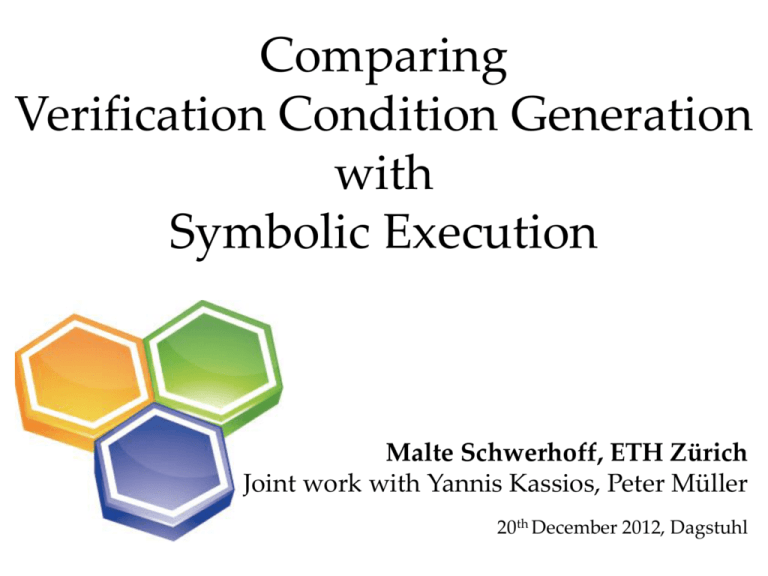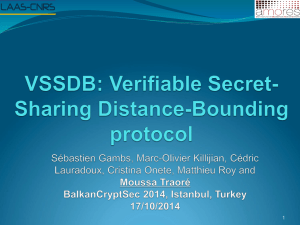PPTX - ETH Zürich
advertisement

Comparing
Verification Condition Generation
with
Symbolic Execution
Malte Schwerhoff, ETH Zürich
Joint work with Yannis Kassios, Peter Müller
20th December 2012, Dagstuhl
Outline
1. Background
2. Verifiers
3. Benchmark
2
Background
3
Modular Verification
∙ Chalice, a research language developed at Microsoft and ETH
∙ Classes and objects
∙ Fork-join concurrency with static deadlock detection
∙ Asynchronous communication via message passing channels
∙ User provided specifications
∙ Framing via Implicit Dynamic Frames (close to Separation Logic)
∙ Pre- and postconditions, loop invariants
∙ Pure functions for information hiding and specifications
∙ Abstract predicates
∙ Shared data due to fractional permissions, monitors and locks
∙ rd(o.f) && acc(o.g, 100%)
is read access to o.f and write access to o.g
4
Verification condition generation vs. symbolic execution
one weakest
precondition per
method
Program
read by
Verifier
calculates
WPs
given to
Prover
VCG
→ Query prover once per method with all available information
Program
symbolically execute
every path through
every method
maintains
read by
Verifier
Symbolic State σ
SE
used by
Prover
query prover at every step if
next statement is executable
σ1
σ2 σ3
σ4 σ 5
→ Query prover often with limited information
5
Verifiers
6
VCG-based Chalice verifier: Chalice
∙ Encodes a Chalice program in the intermediate verification
language Boogie
∙ Heaps and permissions are encoded in Boogie as updateable
maps
∙ state: (H, Π)
∙ Boogie verifier computes weakest preconditions and uses a
prover (currently Z3) to discharge proof obligations
∙ correctness criterion: PRE ⇒ wp(BODY, POST)
7
VCG-Chalice: Example verification
class Cell {
var x: int
function get(): int
requires rd(x)
{ x }
method set(y: int)
requires acc(x)
ensures acc(x) && get() == y
{ x := y }
}
8
VCG-Chalice: Example verification
class Cell {
var x: int
function get(): int
requires rd(x)
{ x }
method set(y: int)
requires acc(x)
ensures acc(x) && get() == y
{ x := y }
}
passed to the prover:
method client(c: Cell, y: int)
PRE ⇒ WP(BODY, POST)
requires acc(c.x)
ensures acc(c.x) && c.get() == y + 1
{
// Π(c,x)=100 ⇒ (Π(c,x)=100 ∧ ∀ u • (Π(c,x)=100 ∧ Cell.get(H[(c,x)↦u],Π,c)=y
// ⇒ (Π(c,x)=100 ∧ Cell.get(H[(c,x)↦H(c,x)+1][(c,x)↦u],Π,c)=y+1)))
// Π(c,x)=100 ∧ (∀ u • (Π(c,x)=100 ∧ Cell.get(H[(c,x)↦u],Π,c)=y
// ⇒ (Π(c,x)=100 ∧ Cell.get(H[(c,x)↦H(c,x)+1][(c,x)↦u],Π,c)=y+1)))
WP(BODY,
call c.set(y)
POST)
// Π(c,x)=100 ∧ Cell.get(H[(c,x)↦H(c,x)+1],Π,c)=y+1
c.x := c.x + 1
// Π(c,x)=100 ∧ Cell.get(H,Π,c)=y+1
POST
}
9
SE-based Chalice verifier: Syxc
∙ Symbolic execution with a symbolic state (γ, h, π) comprising:
∙ Store γ mapping local variables to symbolic values (terms)
∙ Symbolic heap h consisting of heap chunks
r.f ↦ v # p
“field r.f has the value v and we have p permissions to the field”
∙ Path condition π with assumptions such as v > 0, r ≠ null
∙ Verifier manages h, discharges permission (spatial) assertions
∙ Prover manages π, discharges boolean assertions
∙ Idea: Divide the work, gain performance
10
Syxc: Example verification
class Cell {
var x: int
method set(y: int)
requires acc(x)
ensures acc(x) && get() == y
{ x := y }
function get(): int
requires rd(x)
{ x }
}
method client(c: Cell, y: int)
requires acc(c.x)
ensures acc(c.x) && c.get() == y + 1
{
// γ: {c ↦ tc, y ↦ ty}
// h: {tc.x ↦ tx # 100}
// π: {}
call c.set(y)
Verifier finds write access
to c.x in h
// h: {tc.x ↦ tx' # 100}
Verifier
finds write
// π: {Cell.get(tc, tx') == ty ∧ Cell.get(tc, tx')
== tx'}
c.x := c.x + 1
to c.x in h
access
// h: {tc.x ↦ tx' + 1 # 100}
// π: {Cell.get(tc, tx') == ty ∧ Cell.get(tc, tx') == tx‚
//
∧ Cell.get(tc, tx' + 1) == tx' + 1}
}
Verifier finds write access to c.x in h
Prover proves π ⇒ c.get() == y + 1
11
Syxc: State separation consequences
∙ Separation between heap and path conditions has consequences
method client(x: Cell, y: Cell)
exec requires rd(x.f) && rd(y.f)
x
y
Store
(Syxc)
tx
ty
Heap
(Syxc)
{
if (x == y) {
assert x.f == y.f
f#ε
}
}
tv
f#ε
tw
Path cdts.
(prover)
12
Syxc: State separation consequences
∙ Separation between heap and path conditions has consequences
method client(x: Cell, y: Cell)
requires rd(x.f) && rd(y.f)
{
exec if (x == y) {
assert x.f == y.f
x
y
Store
(Syxc)
tx
ty
Heap
(Syxc)
f#ε
}
}
tv
f#ε
tw
tx == ty
Path cdts.
(prover)
13
Syxc: State separation consequences
∙ Separation between heap and path conditions has consequences
method client(x: Cell, y: Cell)
requires rd(x.f) && rd(y.f)
{
if (x == y) {
exec
assert x.f == y.f
// Would fail naively because
// tv == tw is unknown to the prover
}
}
x
y
Store
(Syxc)
tx
ty
Heap
(Syxc)
f#ε
tv
f#ε
tw
tx == ty
Path cdts.
(prover)
∙ Heap compression: Modify h according to π
14
Syxc: State separation consequences
∙ Separation between heap and path conditions has consequences
method client(x: Cell, y: Cell)
requires rd(x.f) && rd(y.f)
{
if (x == y) {
exec
assert x.f == y.f
// Holds
x
y
tx
Store
(Syxc)
Heap
(Syxc)
f#2ε
}
}
tv
tx == ty
tv == tw
Path cdts.
(prover)
∙ Heap compression: Modify h according to π
∙ 𝒪 (n2) calls to the prover
∙ Newly added equalities require fix-point iteration: 𝒪 (n3)
15
Syxc: Branching
∙ Symbolic execution branches on conditionals
→ possible explosion of the number of paths
method client(x: Cell, b: bool)
requires b ==> acc(x.f) // Impure conditional
{ ... }
∙ Two execution paths with different h and π
1. h contains chunk tx.f ↦ tv # 100, π contains b
2. h does not contain such a chunk, π contains ¬b
16
Syxc: Branching
method client(b: bool, i: int)
requires b ==> i > 0 // Pure conditional
{ ... }
∙ Detected while benchmarking, Syxc was been 4x slower
∙ The precondition is pure, i.e., it does not affect the heap
∙ Encode it as a pure implication tb ⇒ ti > 0
∙ Add it to π, continue without branching (but the prover still needs to branch)
∙ Decreases verification time significantly
∙ Our assumption: Additional knowledge allows the prover to optimise
17
Syxc: Other separation consequences
method client(x: Cell, y: Cell)
requires acc(x.f, 60%) && acc(y.f, 60%)
{ assert x != y }
∙ Information in h influence π
∙ Heap chunks suppress uncertainty
∙ Empty π, prover reports ‘unknown’ for both ‘b’ and ‘¬b’
∙ Empty collection (e.g., h), verifier reports ‘false’ for both ‘contains b/¬b’
∙ Sound for permissions because they cannot be negated
∙ Unsound when modelling other properties via heap chunks
18
Benchmark
19
Setup
∙ Benchmarked
∙ 22 succeeding and 7 failing tests from the Chalice test suite
∙ 66 seeded failing test cases
∙ Comparable setup: same parser, same Z3 version & settings
∙ Average statistics over ten runs per tool and test case
20
Metrics
∙ Execution time (seconds)
∙ Quantifier instantiations in the prover
∙ The less QIs a method provokes, the more predictable/robust it is
∙ Extreme example (the matching loop):
forall x:int :: f(x) == f(g(x))
∙ Conflicts generated by the prover
∙ Roughly: the more conflicts a prover causes, the more proof space it explores
21
Results
∙ Average performance of Syxc relative to Chalice
RT
QI
C
Hold (22)
32% (8% – 47%) 5% (0.2% – 19%)
31% (4% – 192%)
Fail (73)
31% (3% – 43%) 9% (0.2% – 85%)
39% (0% – 334%)
22
Results
∙ Average performance of Syxc relative to Chalice
RT
QI
C
Hold (22)
32% (8% – 47%) 5% (0.2% – 19%)
31% (4% – 192%)
Fail (73)
31% (3% – 43%) 9% (0.2% – 85%)
39% (0% – 334%)
Hold > 100/75/25%
0/0/17
0/0/0
1/1/9
Fail > 100/75/25%
0/0/60
0/1/5
8/11/24
23
Conclusions
∙ Test suite is still rather small, results have to be taken with
caution!
∙ Results indicate that in the case of VCG-Chalice vs. Syxc
∙ SE is faster (runtime)
∙ SE is more predictive (QIs)
∙ SE tends to be more focused (conflicts)
∙ The number of QIs is significantly smaller due to state separation
into heap and path conditions
∙ Less information for the prover, less non-goal-directed work
∙ Separation of labour between verifier and prover seems beneficial
∙ However, limited information might not always be beneficial, as
hinted at by the branching problem
24
Current and upcoming work
∙ Syxc
∙ Immutable (frozen) data structures
∙ Class and trait inheritance
∙ Debugger
∙ Syxc retires, reuse experience and target Scala
∙ Immutability
∙ Inheritance
∙ Actor concurrency
∙ ...
∙ Tool chain: Round tripping between SE Verifier, AI Inferer, Slicer
25
The End
Backup Slides
Chalice: a Cell example and access permissions
class Cell {
var x: int
function get(): int
requires rd(x)
{ x }
method set(y: int)
requires acc(x)
ensures acc(x) && get() == y
{ x := y }
}
∙ General access permissions: acc(o.x,p), where 0<p<=100
∙ p<100 grants read access
∙ p==100 grants write access
∙ sum of all permissions to o.x at any given time: 100
∙ rd(x) grants infinitesimal permission ε
28
Chalice: Example
class Cell {
var x: int
predicate P { acc(x) }
function get(): int
requires rd(P)
{ unfolding rd(P) in x }
method set(y: int)
requires P
ensures P && get() == y
{
unfold P
x := y
fold P
}
class Client {
method fails(c: Cell)
requires c.P
{
fork tk1 := c.set(1)
fork tk2 := c.set(2) // ERR
}
method succeeds(c: Cell)
requires c.P
{
fork tk1 := c.clone()
fork tk2 := c.clone()
}
}
method clone() returns (c: Cell)
requires rd(P)
ensures rd(P) && c.P && c.get() == get()
{
c := new Cell
fold c.P
call c.set(get())
}
}
29
Tools
∙ Latest Chalice version uses a new permission model not yet
supported by Syxc, hence we had to use a slightly outdated
Chalice version
∙ Syxc uses Chalice (as a library) to parse input into an AST
∙ Recent Boogie version; limited to one error per Chalice method
∙ Z3 3.1, smtlib2 frontend via std-io, interaction is logged in a file
∙ Syxc uses nearly the same Z3 settings as Chalice does, except
∙ Syxc requires Z3 to respond to every command, not only to check-sat
∙ Syxc uses global declarations, not scope-local ones
∙ Other differences:
∙ Syxc encodes snapshots, references and lists as Z3 integers
→ might increase the number of quantifier instantiations
∙ Syxc uses Boogie’s sequence axiomatisation, but they range over integers
only, whereas Boogie’s are polymorphic
→ might increase the workload for Z3
30
Results
∙ A closer look at the 9 cases where Syxc causes more conflicts
∙ 1 holds, 8 fail
∙ 6 out of these 9 are variations (seeded) of only 2 original programs
∙ The 9 cases perform relatively poor in general
∙ 7 Runtimes above average
∙ 6 Quantifier instantiations above average
31
Results
File
Name
AVLTree.iterative
AVLTree.nokeys
Cell
CopyLessMessagePassing
CopyLessMessagePassing-w/a
CopyLessMessagePassing-w/a2
Dining-philosophers
Iterator
Iterator2
LoopLockChange
OwickiGries
PetersonsAlgorithm
ProdConsChannel
Producer-consumer
Quantifiers
RockBand
Sieve
Swap
Prog1
Prog2
Prog3
Prog4
Syxc
LOC Meth. Time (s)
212
3
1.96
572
19
13.25
131
11
1.62
54
3
1.38
62
3
1.55
66
3
1.55
74
3
1.55
123
6
2.59
111
6
1.56
69
5
1.17
31
2
1.16
70
3
1.88
78
6
1.37
171
11
1.72
28
1
1
109
13
1.03
56
4
1.52
19
2
0.99
33
4
0.97
52
7
1.24
163
16
1.35
19
1
0.91
QI
263
2320.2
235
217
773
852
1765.6
398.2
188
204
124
1247
279
515.8
36
22
830
74
25
79
314
10
Chalice
Conflicts Time (s)
153.6
1895.9
41.2
33
70
74
128
606.9
37
38
41
269.2
117.4
138.4
25
14
177
21
4
14
92.1
3
15.1
171.45
5.62
3.71
3.89
4.19
4.49
5.47
5.17
3.7
3.34
11.05
4.26
7.71
2.65
2.63
6.72
2.58
2.4
4.31
3.78
2.35
QI
146362
2424408
9736
4779
4014
10492
17144
7577
12867
2632
5727
166647
4648
17293
1101
258
21938
877
196
9138
7596
261
Syxc rel. to Chalice
Conflicts Time (%)
1287
19455
536
210
181
323
416
316
304
207
206
1504
317
584
106
28
689
60
12
341
249
20
12.98
7.73
28.83
37.2
39.85
36.99
34.52
47.35
30.17
31.62
34.73
17.01
32.16
22.31
37.74
39.16
22.62
38.37
40.42
28.77
35.71
38.72
QI (%) Conflicts (%)
0.18
0.1
2.41
4.54
19.26
8.12
10.3
5.26
1.46
7.75
2.17
0.75
6
2.98
3.27
8.53
3.78
8.44
12.76
0.86
4.13
3.83
11.93
9.75
7.69
15.71
38.67
22.91
30.77
192.06
12.17
18.36
19.9
17.9
37.03
23.7
23.58
50
25.69
35
33.33
4.11
36.99
15
∙ Longest method (iterative); longest example (nokeys)
∙ Best runtime (13%) and quantifier instantiation (0.1%)
32
Results
File
Name
AVLTree.iterative
AVLTree.nokeys
Cell
CopyLessMessagePassing
CopyLessMessagePassing-w/a
CopyLessMessagePassing-w/a2
Dining-philosophers
Iterator
Iterator2
LoopLockChange
OwickiGries
PetersonsAlgorithm
ProdConsChannel
Producer-consumer
Quantifiers
RockBand
Sieve
Swap
Prog1
Prog2
Prog3
Prog4
Syxc
LOC Meth. Time (s)
212
3
1.96
572
19
13.25
131
11
1.62
54
3
1.38
62
3
1.55
66
3
1.55
74
3
1.55
123
6
2.59
111
6
1.56
69
5
1.17
31
2
1.16
70
3
1.88
78
6
1.37
171
11
1.72
28
1
1
109
13
1.03
56
4
1.52
19
2
0.99
33
4
0.97
52
7
1.24
163
16
1.35
19
1
0.91
QI
263
2320.2
235
217
773
852
1765.6
398.2
188
204
124
1247
279
515.8
36
22
830
74
25
79
314
10
Chalice
Conflicts Time (s)
153.6
1895.9
41.2
33
70
74
128
606.9
37
38
41
269.2
117.4
138.4
25
14
177
21
4
14
92.1
3
15.1
171.45
5.62
3.71
3.89
4.19
4.49
5.47
5.17
3.7
3.34
11.05
4.26
7.71
2.65
2.63
6.72
2.58
2.4
4.31
3.78
2.35
QI
146362
2424408
9736
4779
4014
10492
17144
7577
12867
2632
5727
166647
4648
17293
1101
258
21938
877
196
9138
7596
261
Syxc rel. to Chalice
Conflicts Time (%)
1287
19455
536
210
181
323
416
316
304
207
206
1504
317
584
106
28
689
60
12
341
249
20
12.98
7.73
28.83
37.2
39.85
36.99
34.52
47.35
30.17
31.62
34.73
17.01
32.16
22.31
37.74
39.16
22.62
38.37
40.42
28.77
35.71
38.72
QI (%) Conflicts (%)
0.18
0.1
2.41
4.54
19.26
8.12
10.3
5.26
1.46
7.75
2.17
0.75
6
2.98
3.27
8.53
3.78
8.44
12.76
0.86
4.13
3.83
11.93
9.75
7.69
15.71
38.67
22.91
30.77
192.06
12.17
18.36
19.9
17.9
37.03
23.7
23.58
50
25.69
35
33.33
4.11
36.99
15
∙ Similar behaviour for test case PetersonsAlgorithm: Runtime speedup
above average, very low QI ratio
33
Results
File
Name
AVLTree.iterative
AVLTree.nokeys
Cell
CopyLessMessagePassing
CopyLessMessagePassing-w/a
CopyLessMessagePassing-w/a2
Dining-philosophers
Iterator
Iterator2
LoopLockChange
OwickiGries
PetersonsAlgorithm
ProdConsChannel
Producer-consumer
Quantifiers
RockBand
Sieve
Swap
Prog1
Prog2
Prog3
Prog4
Syxc
LOC Meth. Time (s)
212
3
1.96
572
19
13.25
131
11
1.62
54
3
1.38
62
3
1.55
66
3
1.55
74
3
1.55
123
6
2.59
111
6
1.56
69
5
1.17
31
2
1.16
70
3
1.88
78
6
1.37
171
11
1.72
28
1
1
109
13
1.03
56
4
1.52
19
2
0.99
33
4
0.97
52
7
1.24
163
16
1.35
19
1
0.91
QI
263
2320.2
235
217
773
852
1765.6
398.2
188
204
124
1247
279
515.8
36
22
830
74
25
79
314
10
Chalice
Conflicts Time (s)
153.6
1895.9
41.2
33
70
74
128
606.9
37
38
41
269.2
117.4
138.4
25
14
177
21
4
14
92.1
3
15.1
171.45
5.62
3.71
3.89
4.19
4.49
5.47
5.17
3.7
3.34
11.05
4.26
7.71
2.65
2.63
6.72
2.58
2.4
4.31
3.78
2.35
QI
146362
2424408
9736
4779
4014
10492
17144
7577
12867
2632
5727
166647
4648
17293
1101
258
21938
877
196
9138
7596
261
Syxc rel. to Chalice
Conflicts Time (%)
1287
19455
536
210
181
323
416
316
304
207
206
1504
317
584
106
28
689
60
12
341
249
20
QI (%) Conflicts (%)
12.98
7.73
28.83
37.2
39.85
36.99
34.52
47.35
30.17
31.62
34.73
17.01
32.16
22.31
37.74
39.16
22.62
38.37
40.42
28.77
35.71
38.72
0.18
0.1
2.41
4.54
19.26
8.12
10.3
5.26
1.46
7.75
2.17
0.75
6
2.98
3.27
8.53
3.78
8.44
12.76
0.86
4.13
3.83
11.93
9.75
7.69
15.71
38.67
22.91
30.77
192.06
12.17
18.36
19.9
17.9
37.03
23.7
23.58
50
25.69
35
33.33
4.11
36.99
15
∙ Conflicts are less conclusive:
Iterator: conflicts above average, QI below average, still twice as fast
34




